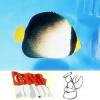Bro Klim,
Don't panic
Isopods are very easy and fun to remove. They are great scavengers and absolutely love blood!
Here's how:
Go market, NTUC, Sheng Siong etc and get hold of some small size kuning or kambong fish.
You only need two pcs.
A length of string longer than your tank depth and a fish net.
Preparation:
Scale the fish and wash clean.
Cut a 2.5inch section, taking the head to the belly portion. Don't wash anymore.
This is your bait
This is what you do:
Tie the bait to one end of the string.
Peel open the gill cover to expose the gill.
Give the gill a pinch till a bit of blood trickle out.
Lower the bait to the tank bottom and watch
The blood trail will start to drift with the flow.
Soon, you will see all the isopods 'fly' excitedly out of the substrates and home towards the bait.
In no time, the bait will be swamped with voracious isopods eating right into the carcass. Goosebumps!
The actions can be so dractic the entire carcass seem to come alive and start 'moving'
When a good number are seen devouring the bait, raise the bait with string GENTLY while at the same time, scoop the whole thing up with the fish net.
Walla you get a big bunch of isopods for a cool macro shot
Tip : Do not wait for every single isopod to land on the bait before pulling the plug 'cos those that have their fill will quickly leave. You can follow up with the next baiting.
Have fun












